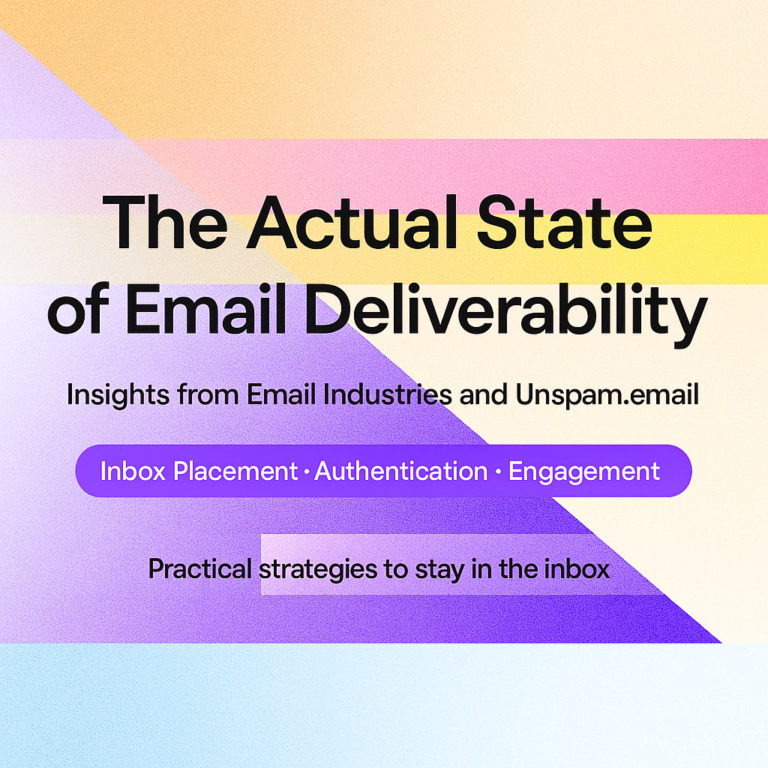Have you ever wondered why some of your emails have successfully reached subscribers’ inboxes while others landed in the spam folder or were rejected? As it turns out, your content, offer, and design are not the only variables that can make or break your campaign. Many other small yet crucial factors are in the game.
Email marketing is a complex and tricky field. It might seem simple on the surface, but deep inside, it is advanced with multiple things determining the success of deliverability and email campaign performance. The list is pretty long, from the quality of the subscription list to the well-placed call-to-action button. However, the email sender’s reputation is among the most critical. ISPs and ESPs acknowledge it as the decisive factor in passing their security barriers.
Let’s explore this topic to understand why companies should improve sender score regularly and what tactics they may adopt to keep it strong.
What Is Email Sender Score?
Email sender score is a key variable in email marketing responsible for the bigger part of campaign performance. Inbox service providers, email providers, anti-spam services, and blacklist vendors use it to assess a company’s behavior in the channel.
In simple terms, an email sender score is a digital number that ranges from 0 to 100. It is assigned to every company that communicates with subscribers through digital newsletters. This includes regular and bulk senders and covers all types of emails, such as informative, promotional, and transactional.
The higher it is, the more chances email will pass security barriers and land in the inbox. The lower it is, the more email risks to be thoroughly inspected and either directed to the spam folder or rejected. The company may even land in the email provider’s blocklist in the worst-case scenario.
Quite often, the email sender score is referred to as email sender reputation because it determines the opinion of key email environment participants about the company through quantitative representation.
Finally, the email sender score is based on many factors and is regularly re-calculated to reflect the current company’s level of trustworthiness and credibility. Every company’s action or effort (email campaign, choice of ESP, subscribers’ engagement) may positively or negatively affect it. To understand it better, you should learn what it includes and what factors may influence it.
The Core Elements of Email Sender Score
The email sender score is a complex accumulative metric. It is composed of IP reputation and domain reputation.
IP address reputation describes the trustworthiness of an IP address from which a company sends its digital newsletters. It reflects the device’s behavioral quality, credibility, and legitimacy and the company’s actions. It is based on the IP address’s past and current behavior.
Domain reputation is a digital measure that demonstrates the overall “health” and current condition of the company’s branded domain or domain that ESP uses to send the company’s emails. It is based on sending behavior over a certain period. Unlike IP address reputation, it reflects the brand’s activity and presence in the channel rather than the technical side of the company’s existence.
These metrics demonstrate the trust inbox providers and other key participants of email channels place in the company and its digital correspondence with clientele.
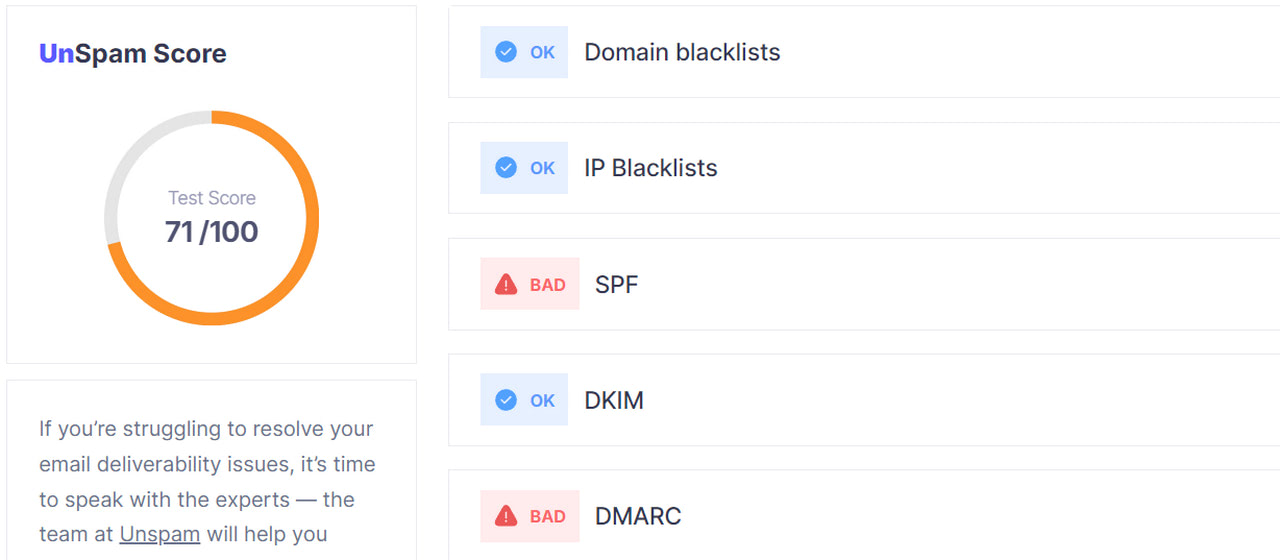
Sender score calculated by Unspam
Factors Influencing Sender Score
Truthfully, ISPs and mailbox providers do not tell you how they assess a company’s behavior, nor explain why they give it such a score. To make matters worse, each core service has its algorithm and parameters for delivery and inbox placement to gauge email sender scores.
However, the good news is that they give us insights into what might affect email sender reputation through their regularly updated recommendations and postmaster tools. According to that, here are the most popular factors that may influence the sender’s reputation.
Consult our email deliverability consultants to maximize sender reputation.
Infrastructure
This core aspect includes everything from IP addresses to security authentication protocols. Every device and program involved in creating and maintaining the email environment affects the sender’s score to varying degrees.
For example, suppose the company does not have security email authentication protocols tuned properly to ensure the credibility and legitimacy of their email correspondence. In that case, email providers may easily reject their digital newsletters and decrease their sender reputation. With Gmail and Yahoo having recently announced new rules for all senders, the company may even lose all its privileges to connect with its subscribers.
Another good case in point is the usage of shared IP addresses that many startups and small businesses abuse. Little do they know that by sharing resources with others, they may suffer the consequences of their negligent neighbors. If one of them is caught in malicious activity, the IP address and everyone who uses it loses its credit.
Sending History
Sending history of IP and domain matters for ISPs for many reasons. However, the most critical one is that it describes the company’s long-term behavior and position in the market. Companies must behave well and respectfully to their clientele and all key participants in the email channel to deserve the right to work there.
If an IP address or domain was caught in malicious activity, it would be treated cautiously and even flagged as a potentially problematic device. Even if a company uses a new domain or IP address without any email sending history, it is still on the radar. The deal is that ISPs only start to build their opinions about that, so they consider it skeptically.
Spam Complaints
Abuse complaints happen when a subscriber marks an email as spam or leaves a direct report for spam. It indicates that the company’s communication with its subscribers is not genuine, authentic, or valuable. Another reason is that the company does not allow its contacts to unsubscribe, which is a no-no practice in email. These scenarios are not welcome by ISPs, mailbox providers, and especially blacklist vendors.
Therefore, the higher the complaint rate, the more likely the company’s emails will trigger spam filters or be rejected by the email provider, and ipso facto lower the sender score.
Industry blacklists
Being blacklisted by one of the leading providers is the worst-case scenario that could happen to the company. Blacklisting is a definite sign that the business disobeyed well-established rules or adopted “grey” practices.
The consequences of such behavior and activity vary. However, as a rule, the company loses its privileges to reach subscribers and communicate with them via email. ISPs and email clients reject its digital correspondence and cut back the sender’s reputation.
Email List Quality
Email list quality is directly linked to the hard bounce rate, which describes the percentage of digital newsletters that cannot be delivered for permanent reasons: either the contact address does not exist, or the company is blocked by the ISP or mailbox provider for its reasons. It is also connected with a number of spam traps and disengaged subscribers.
Poorly maintained email lists raise suspicious signaling to ISPs and other participants that the company prioritizes quality over quantity or uses “grey” tactics for building their subscription list, like buying contacts from third-party brokers. This behavior is not acceptable.
Email Content
Email sender reputation goes beyond technical aspects of the company’s behavior in the email channels. Trivial details like email content are also important to the overall reputation algorithm.
If a company sends low-quality email content that does not engage subscribers, it will receive low email deliverability metrics, conversion rates, and open rates next time. In some cases, it may even get a high unsubscribe rate. Low email marketing rates mean the company sends invaluable content or even spam their contacts, so it does not deserve a place in their inbox or a high sender score.

High-converting, fully responsive email design by Designmodo
What Is a Good Email Sender Score?
So, the email sender score is a complex, accumulative record describing everything concerning the company’s presence in an email channel. It reflects its infrastructure, intentions, attitude to subscribers, and even how well emails have performed. Therefore, it is crucial to maintain a high level at all times. However, what high is high?
According to general connotations, a sender score that is higher than 80 is considered to be good. A company that ranks above that rate easily passes ISP tests and gets to subscribers’ inboxes without causing suspicion. They look trustworthy, credible, and legitimate.
Companies with sender scores between 70 and 80 may look questionable to some ISPs and email providers, as this range indicates something is wrong. Reasons vary: it could be a poorly performed email campaign, incorrectly set up security authentication protocol, or even blacklisting by some small providers.
Companies with a sender score of less than 70 are in a red zone. They are closely inspected and can be easily rejected by email providers.
How to Check Sender Score?
Email sender score check-up is one of the most critical steps in the email marketing routine. It is done right before initiating an email campaign to assess the chances of the digital newsletter being regarded by ISPs and email clients as trustworthy and ipso facto placed right into the subscriber’s inbox.
Not only does regular email sender check-up ensure that the company’s emails reach intended recipients and that email marketing efforts are not in vain, but it also surfaces issues with deliverability, infrastructure, and campaign, giving a solid ground to introduce improvements and secure much-needed conversions and revenue.
So, how do you check the email sender score? The easiest, simplest, and most reliable way is to use dedicated online tools. As there is no one-size-fits-all solution and a singular sender score algorithm that ISPs or email clients use for evaluation, these third-party instruments are life-savers that help companies navigate this chaos and understand this rate.
Even though these instruments might use different approaches, they are all guided by the best practices in the niche and recommendations given by big players in the email arena. Some of them are oversimplified, giving you only the basic information. In contrast, others may tell the whole story behind your email sender reputation and reveal hidden challenges and faux pas impeding your email campaign and strategy. One such comprehensive yet handy-to-use tool is Unspam.
Unspam is a fully-fledged, robust email spam checker and email deliverability test platform. It is reliable, trustworthy, and widely approved by companies across niches. Its priority lies in analyzing the entire concept of email deliverability.
The platform conducts a well-rounded analysis of IP address, sending domain, blacklisting, content, link quality, subject line, accessibility, inbox placement, and security authentication protocols. It inspects and assesses every aspect thoroughly to give a score and reveal some hidden issues.
In addition, it generates a heat map to predict the results of your email newsletter performance and allows companies to preview their emails across popular screen sizes. This gives email marketers a knowledge base to improve their campaigns from different angles, avoid spam filters, and optimize delivery.
Last but not least, despite its advanced approach, the platform is easy to use and handle. It has an intuitive interface and presents information in an easily digestible, well-structured manner. To initiate a sender score check-up, you must craft an email and send it to the testing email address. In a few seconds, you will get a full report and crucial information to improve sender score.
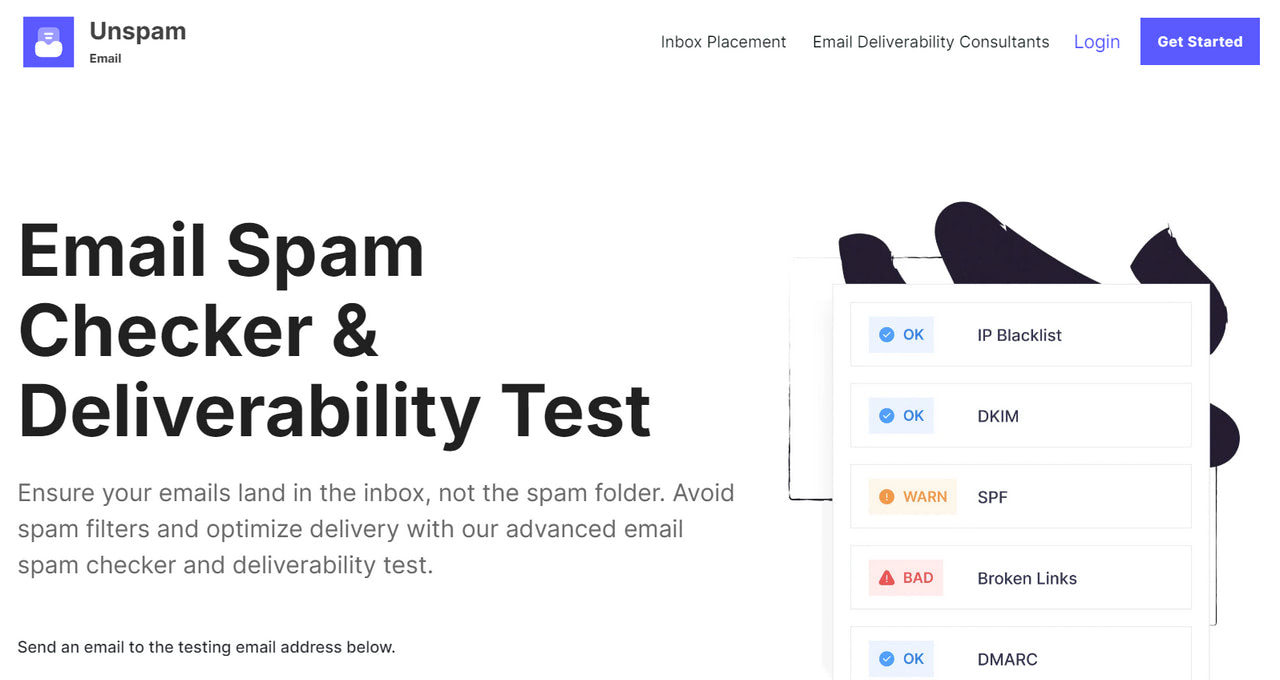
If you need a simple calculation of the email sender score, you may try these alternative options:
Talos Intelligence. Free and simple, this time-proven tool assesses a company’s domain and IP reputation score in real time. Unlike others, it does not provide you with a traditional number but reflects it on a three-level scale: Good, Neutral, or Poor.
“Good” means the company is considered trustworthy, so most of its emails will land in subscribers’ inboxes. “Neutral” means the company’s emails might be filtered in some cases due to security reasons. “Poor” means issues with inbox placement and rejection from ISPs.
Google Postmaster Tool. If you want to assess your chances of successfully passing Gmail’s filters and security protocols, this is the right tool to ask. Although it requires companies to add custom records to their DNS to get started, it provides all crucial information about email sender scores, authentication, spam reports, delivery errors, and encryption.
Google gives filtered results about IP address and domain reputation with four indicators: bad, low, medium/fair, and high. The first two indicate that companies must take immediate measures to improve sender scores, whereas the last two signify positive outcomes with email campaigns.
Why Is It Important to Improve Sender Score?
Introducing a sender score check-up into your email marketing routine before sending emails to recipients is one of the best practices in the niche. It is an integral part of a reactive strategy that addresses a problem when it already exists.
However, when it comes to the competitive world of email marketing, companies are highly advised to adopt proactive strategies that avoid problems beforehand and reduce the chances of them occurring. That implies taking control and regularly introducing practices to improve sender score. This way, companies protect their reputation and promote positive changes for the company’s presence in the email channel over time.
Apart from adopting a proactive strategy, there are other good reasons to improve sender score regularly. First of all, it helps to fight malicious actors. As spammers and hackers are constantly getting inventive to stay below ISPs’ and ESPs’ radars, companies that constantly enhance their security levels (a procedure that is an integral part of sender score improvement process) get a fighting chance to protect their emails from attacks.
Second, with ISPs and ESPs getting more overprotective of their clients, it is getting tougher and tougher to see through their filters, even for a legitimate newsletter. By constantly improving the email sender’s reputation, the company introduces the best practices crucial to seeing through these regularly updated security barriers.
Third, staying up-to-date with the industry helps the company to meet current regulations. This year, Gmail and Yahoo announced that only fully authenticated emails would pass their barriers, signaling to all senders (regular and bulk) who want to connect with their subscribers to take their email sender reputation seriously. Therefore, those who improve sender score regularly are ready for new rules.
Finally, with a proactive strategy, companies may avoid the aftermath of a poor email sender reputation, as it can seriously damage the overall marketing strategy in this channel. Just consider what consequences companies might face:
- Emails will likely be marked as spam and put into the corresponding folder.
- Emails are likely to be rejected at all.
- Low inbox placement.
- Low deliverability rate.
- Low performance of email campaign.
- Blacklisting from popular security vendors.
- Rejection from ESPs as they avoid clients with suspicious behavior.
It is crucial to note that repairing a poor email sender’s reputation is possible. However, it takes time and lots of effort. That means the company loses its privileges of generating conversions and leads in the channel and the opportunity to communicate and build strong relationships with customers. The longer it takes to recover, the more brand reputation and market positioning will suffer, losing its hardly-earned trust and credibility.
To make matters worse, a low reputation is imprinted in the company’s history. ISPs and ESPs seriously consider it when re-calculating the sender score, which may further drag the recovery.
Conversely, companies that regularly improve sender scores avoid these bad scenarios and, most importantly, enjoy some considerable benefits. As the sender score is a crucial factor in guaranteeing positive email deliverability, businesses may enjoy the high performance of their email campaigns, including high deliverability, open rates, conversions, and much-needed leads to generate revenue. It also means the company’s investments (human resources, money, and time) will not be in vain.
A constantly improved sender score correlates with a brand reputation, ensuring consistency in communication with the client base. It underlies a solid foundation for building healthy and strong relationships, increasing the company’s trustworthiness, and is crucial to cementing its position in the market and fighting economic fluctuations.
Finally, companies often overlook that regularly improved sender scores help ISPs and ESPs identify and suppress cybercriminals more accurately. That means the company establishes itself as a responsible and socially conscious participant in the email arena that does everything to create a safe place for its clients. That position goes a long way.
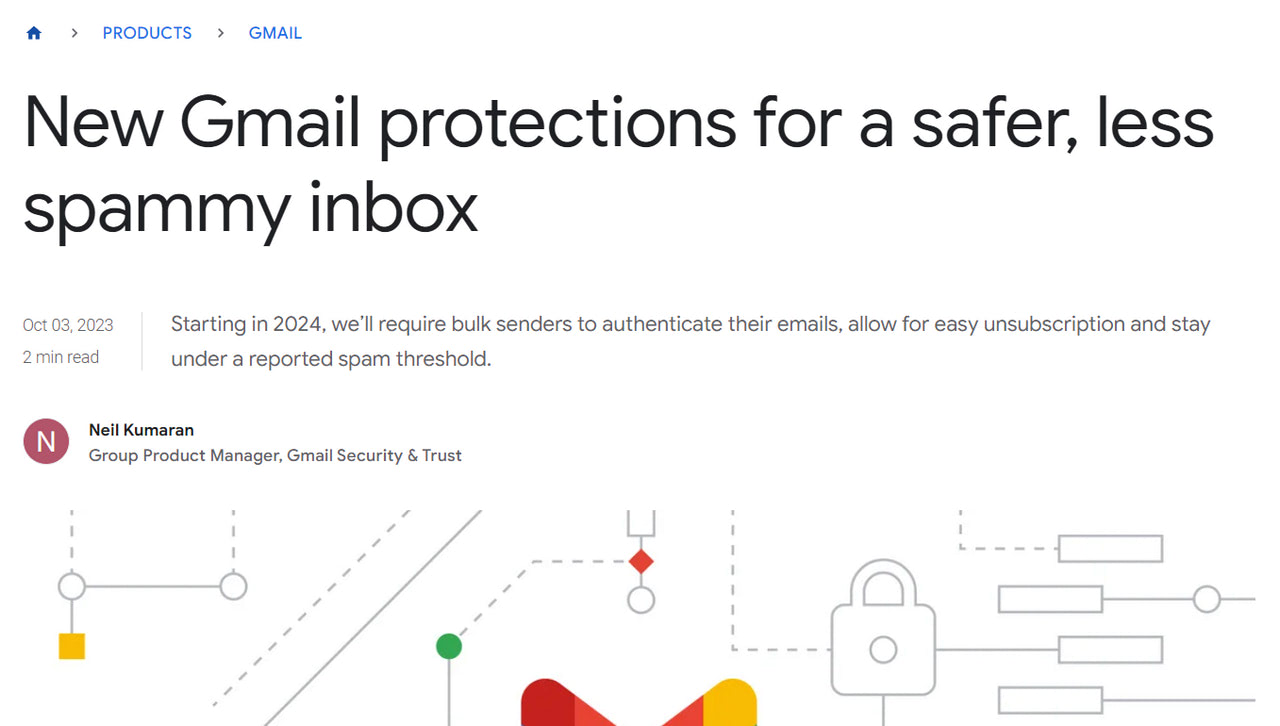
New Gmail protections for a safer, less spammy inbox
How to Improve Sender Score – Proven Tactics and Best Practices
A proactive strategy that implies companies regularly improve sender scores and check them up in advanced tools like Unspam email checker to find weaknesses and hidden faux pas is one of the best ways to ensure successful email marketing. Here are the best practices you might introduce into your routine to adopt it.
Strengthen Technical Side
The technical side of the company’s presence in the email channel is perhaps one of the most critical aspects. ISPs and email providers rely on the technical data they fetch from email to determine the sender score.
Above all, that includes security authentication protocols. SPF, DKIM, DMARC, ARC, and BIMI may tell a lot about the company and its email. If some protocols are poorly configured or fail, it is the first sign to check email rigorously, as it may indicate a cyber-attack or security infringement.
Therefore, the first step to improve sender score is to ensure all authentication protocols are correctly set up. It is important to check them through Unspam to identify and eliminate even the smallest inconsistencies.
Afterward, ensuring high-security standards for your sending server is highly recommended. If you use a popular email service provider, their team takes care of this. However, checking whether they update their security measures regularly is still advisable.
Those who run their email servers should adopt the best practices in the niche and, at minimum, take these measures:
- regularly upgrade server software and operating system;
- introduce access restrictions and limit user permissions;
- ensure encrypted communication through SSL technologies;
- enhance security with a VPN;
- protect with a firewall.
Finally, your domain, aka website, must also be protected. For example, if WordPress powers it, use the latest security plugins. It would also help to run tests and check code files and folders for malicious scripts every month.
Track Your Email Sender Reputation and Key Email Deliverability Metrics
Tracking key email deliverability metrics and email sender reputation over time is a surefire way to identify trends, behavior, and actions that shape sender scores. Delivery rate, open rate, spam complaints, conversion rates, and engagement rate are the most reliable indicators of pending reputation degradation or, on the contrary, improvement.
Watching for these changes on a domain-by-domain and segment-by-segment basis provides crucial knowledge for companies to identify reputation issues unique to specific providers and understand what they prioritize in their security algorithms.
Inspect Blacklist Providers
Use Unspam email checker or similar tools to check whether popular vendors block your IP address or domain. As for small providers, you need to do that manually. As they do not significantly impact delivery rates or the brand’s reputation, many specialized tools do not include them in their routine.
Do not skip this step. As practice shows, if the company starts to appear in small blacklist providers, it indicates its sending reputation is suffering. By checking their recommendations, the company may catch some unique issues with its campaign or activity in email channels and save itself from getting into the radar of big players.
Clean Subscription List Regularly
The importance of a well-maintained subscription list could not be stressed enough for email marketers. Ironically, this procedure is always left as an afterthought. However, good hygiene greatly benefits brands, from improving sender scores to positively influencing email campaign performance. Here are several reasons to clean it up regularly.
First, the subscription list degrades yearly. It is a natural process as customers change their contact addresses, deactivate them, or forget their passwords and abandon their addresses. If you leave these contacts in the list, you risk increasing the hard bounce rate (when an email bounces from the server as an account does not exist) and the soft bounce rate (in the case of autoresponder). Either way, your email sender’s reputation will be compromised.
Second, you may have spam traps. Sending emails to spam traps is the first step towards blacklisting. This brings about bad consequences for the company, apart from decreasing the sender’s score.
Third, the subscription list might have recipients that never open your emails. Even if you have the double opt-in procedure, people may become disengaged with the brand as their preferences and needs change over time. Again, it is another natural process that no one can predict. However, it does not mean you should leave these subscribers without attention. As anything, you should work with these contacts closely as a low open rate and low engagement rate negatively influence the sender score.
Finally, regularly cleaning and validating the subscription lists provides the company with a solid foundation for wholly-grain segmentation, which is crucial for high-converting email campaigns and positive responses from subscribers. Both these factors contribute to the high reputation of email senders.
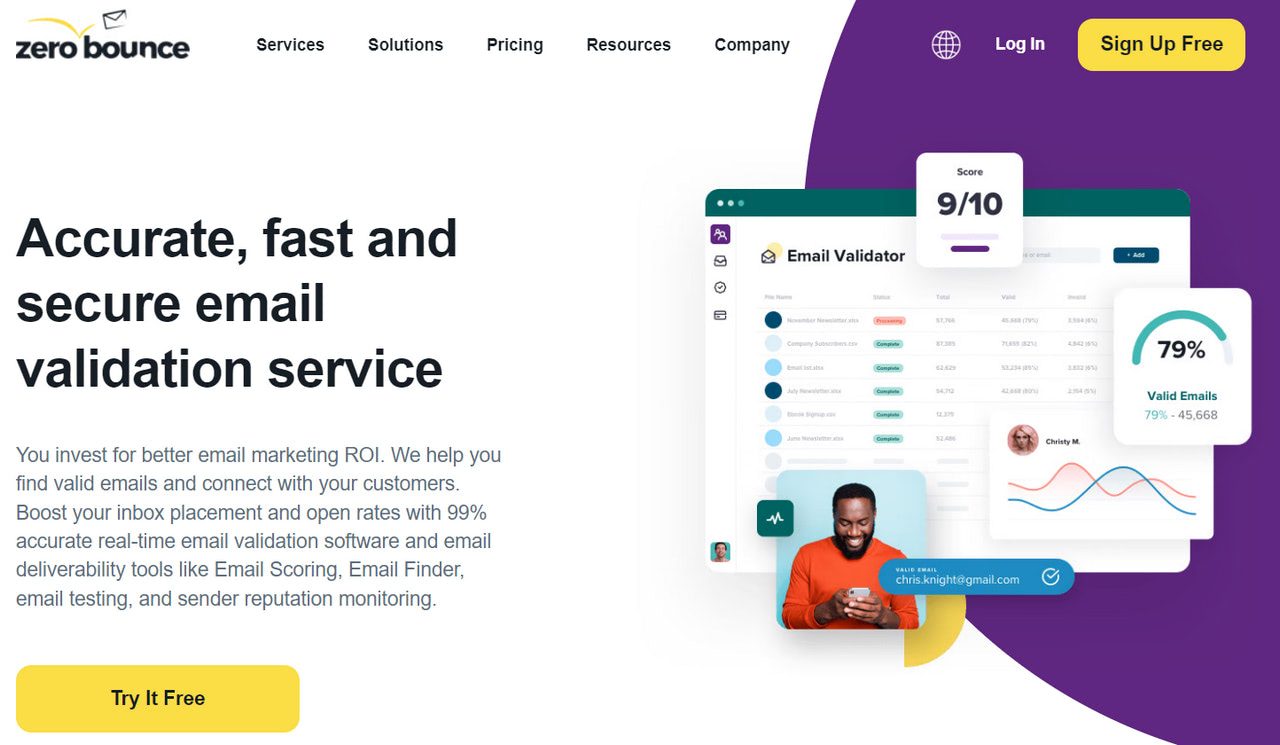
Prioritize Customer-Centric Email Marketing Strategies
Email providers are always overprotective of their clients. They do everything possible to create a safe environment, protecting them from unnecessary clutter in their inboxes. Nothing will stop them from putting your email in the spam folder or rejecting it if it looks unwelcome.
The client’s reaction to the newsletter is one of the critical factors. If contacts constantly move the company’s newsletter to the spam folder, leave it unopen, or register a complaint, they are disengaged with a brand. ESPs take this as approval for routing the company’s emails out of the inbox with some negative consequences for the sender’s reputation.
Therefore, adopting email marketing strategies that prioritize the subscribers’ needs, preferences, and expectations is important. Here are some popular and proven tactics:
- Ensure your email meets all relevant rules, legislations, and compliances.
- Use only responsive and mobile-friendly email templates. Previewing your email in different screen sizes and email clients is highly recommended to avoid any inconsistency or distortion in message delivery.
- Make emails accessible and inclusive. At a minimum, ensure optimal readability and contrast and provide alt texts for graphics and images.
- Let contacts easily unsubscribe from you. Add a link to the email body copy, and most importantly, make this process simple, quick, and easy.
- Bring value to every connection. Create email campaigns with purpose. Ensure clients find your transactional emails (abandoned cart notifications, welcome sequences, and reminders) useful.
- Create hyper-personalized content.
- Do wholly-grained segmentation. Consider micro-segmentation to target your audience more precisely and relevantly.
- Create appealing and informative subject lines. Use the pre-header to support your pitch and drum up interest.
- Stay away from spammy words such as “Free,” “50% off,” “Giveaway,” “Discount,” “Fast,” and “Last Chance!”
- Avoid practices that may trigger spam filters, like adding heavy images or making newsletters extremely large.
- Optimize email content: make it short yet to the point. Avoid informative and visual overload.
- Test all of your links.
- Employ user-generated content and stay transparent with customers’ feedback and reviews.
- Create communicative design through coloring, typography, visuals, and graphics.
- Maintain consistency with your sending schedule. Analyzing contact behavior to find the best cadency and frequency would also help. Alternatively, give your contacts control and let them choose how often they want to hear from you.
- Stay active and trendy. Engage with event marketing tactics that get client responses.
- Do A/B tests.
Mistakes to Avoid and Recommendations to Follow
Apart from introducing these core postulates in your email marketing routine, it is also crucial to avoid some common mistakes and follow recommendations from popular email providers, ISPs, and blacklist vendors that regularly update them to fight cyber-attacks efficiently.
Here are common mistakes that your company should avoid to improve sender score proactively:
- Purchase contacts from third-party vendors.
- Collecting misspelled or invalid email addresses.
- Introduce pushy email marketing tactics.
- Send bulk emails without warming up the domain.
- Practice inconsistency in frequency, cadency, and volume of emails.
- Skip updates in regulations and law enforcement like GDPR or the CAN-SPAM Act.
- Ignore accessibility, inclusivity, and mobile-friendliness in digital newsletters.
- Assume consent for different types of emails and campaigns. Note that consent is not transferrable. You need a subscriber’s permission to send them newsletters for different purposes.
- Offer financial incentives to get consent or compel users to stay.
- Focus on the technical aspect or, on the contrary, prioritize email content and design.
Here are some popular recommendations:
- Use dedicated IPs over shared ones.
- Introduce a double opt-in procedure.
- Process all unsubscribe requests without delay.
- Check the email feedback loop and take action if you notice issues.
- React to spam complaints and address concerns right away.
- Monitor key email deliverability metrics.
- Grow your list organically.
- Be transparent and clear in your communication with subscribers.
- Do not rush, and take your time by adopting white-glove email marketing campaigns that gradually improve your IP and domain reputation.
- Remain clear and transparent in Terms and Conditions.
- Maintain a comprehensive security program to provide a safe environment.
- Ensure safe storage of private customer data.
- Introduce protection against unauthorized or unlawful processing, accidental loss, destruction, or data damage.
For more detailed information, check out Sender Best Common Practices, Version 3 by Messaging Malware and Mobile Anti-Abuse Working Group. This document summarizes all the best practices in the niche email marketers should use.
On top of that, keeping a close eye on any changes introduced to the compliance regulations, such as GDPR, CAN-SPAM Act, CPRA, and CASL, is highly recommended.
Conclusion
The foundation for a good sender reputation is a holistic approach. It requires total commitment and devotion from a company as numerous details must be mastered. From creating a robust email infrastructure with correctly set-up security authentication protocols to adopting the best practices for email design and body copy to minimize spam rate, every aspect of an email campaign, strategy, and brand’s presence influences sender score at varying degrees.
Apart from taking care of these key aspects, the holistic approach also implies that companies improve sender scores regularly. Whether a business has a high level of trust with ISPs, ESPs, and other key participants in the email channel or not, it is highly advisable to take measures that support and enhance email reputation all year round.
This way, companies can enjoy the benefits of consistent access to their subscribers and unlock the potential of email marketing. They will also adopt a proactive rather than reactive strategy that avoids possible issues beforehand, protects the brand’s reputation, and stimulates positive changes across boards.




